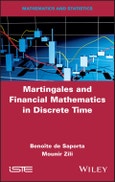The book offers a combination of mathematical teaching and numerous exercises for wide appeal. It is a useful reference for students at the master’s or doctoral level who are specializing in applied mathematics or finance as well as teachers, researchers in the field of economics or actuarial science, or professionals working in the various financial sectors.
Martingales and Financial Mathematics in Discrete Time is also for anyone who may be interested in a rigorous and accessible mathematical construction of the tools and concepts used in financial mathematics, or in the application of the martingale theory in finance
Table of Contents
Preface ix
Introduction xi
Chapter 1 Elementary Probabilities and an Introduction to Stochastic Processes 1
1.1 Measures and σ-algebras 1
1.2 Probability elements 5
1.3. Stochastic processes 16
1.4. Exercises 19
Chapter 2 Conditional Expectation 21
2.1 Conditional probability with respect to an event 21
2.2. Conditional expectation 24
2.3. Geometric interpretation 37
2.4. Conditional expectation and independence 38
2.5. Exercises 41
Chapter 3 Random Walks 45
3.1 Trajectories of the random walk 45
3.2. Asymptotic behavior 52
3.3. The Gambler’s ruin 58
3.4. Exercises 60
Chapter 4 Martingales 63
4.1 Definition 63
4.2. Martingale transform 66
4.3 The Doob decomposition 67
4.4 Stopping time 69
4.5 Stopped martingales 71
4.6. Exercises 75
Chapter 5 Financial Markets 81
5.1. Financial assets 82
5.2. Investment strategies 82
5.3. Arbitrage 84
5.4. The Cox, Ross and Rubinstein model 86
5.5. Exercises 88
5.6. Practical work 90
Chapter 6 European Options 95
6.1 Definition 95
6.2. Complete markets 96
6.3. Valuation and hedging 97
6.4. Cox, Ross and Rubinstein model 98
6.5. Exercises 104
6.6. Practical work: Simulating the value of a call option 106
Chapter 7 American Options 107
7.1 Definition 107
7.2 Optimal stopping 109
7.4. The Cox, Ross and Rubinstein model 115
7.5. Exercises 116
7.6. Practical work 117
Chapter 8 Solutions to Exercises and Practical Work 119
8.1. Solutions to exercises in Chapter1 119
8.2. Solutions to exercises in Chapter2 127
8.3 Solutions to exercises in Chapter3 143
8.4. Solutions to exercises in Chapter4 151
8.5. Solutions to exercises in Chapter5 170
8.6.Solutions to the practical exercises in Chapter5 175
8.7. Solutions to exercises in Chapter6 189
8.8. Solution to the practical exercise in Chapter6 (section6.6) 193
8.9. Solution to exercises in Chapter7 195
8.10. Solution to the practical exercise in Chapter7 (section7.6) 200
References 205
Index 207








